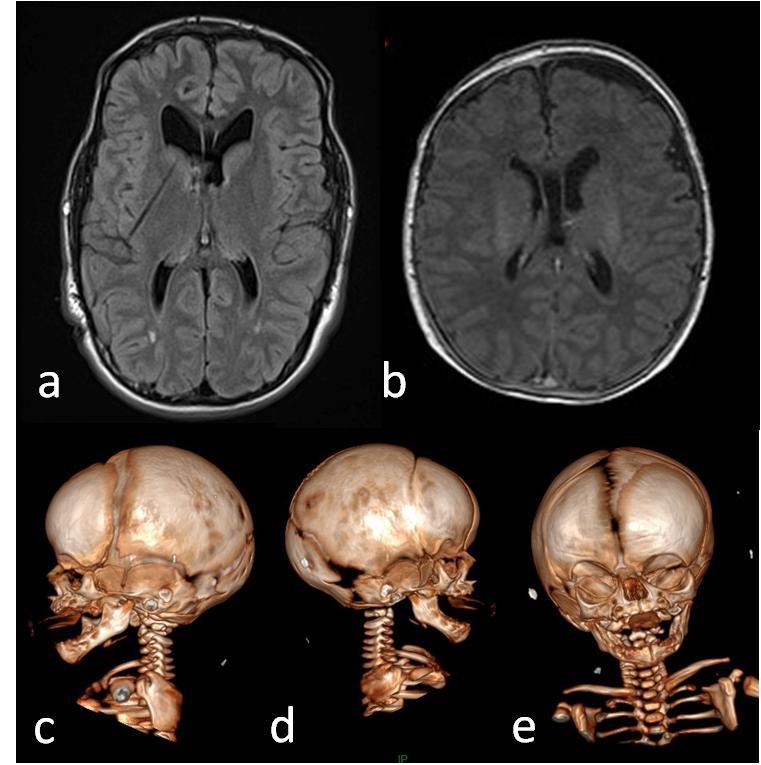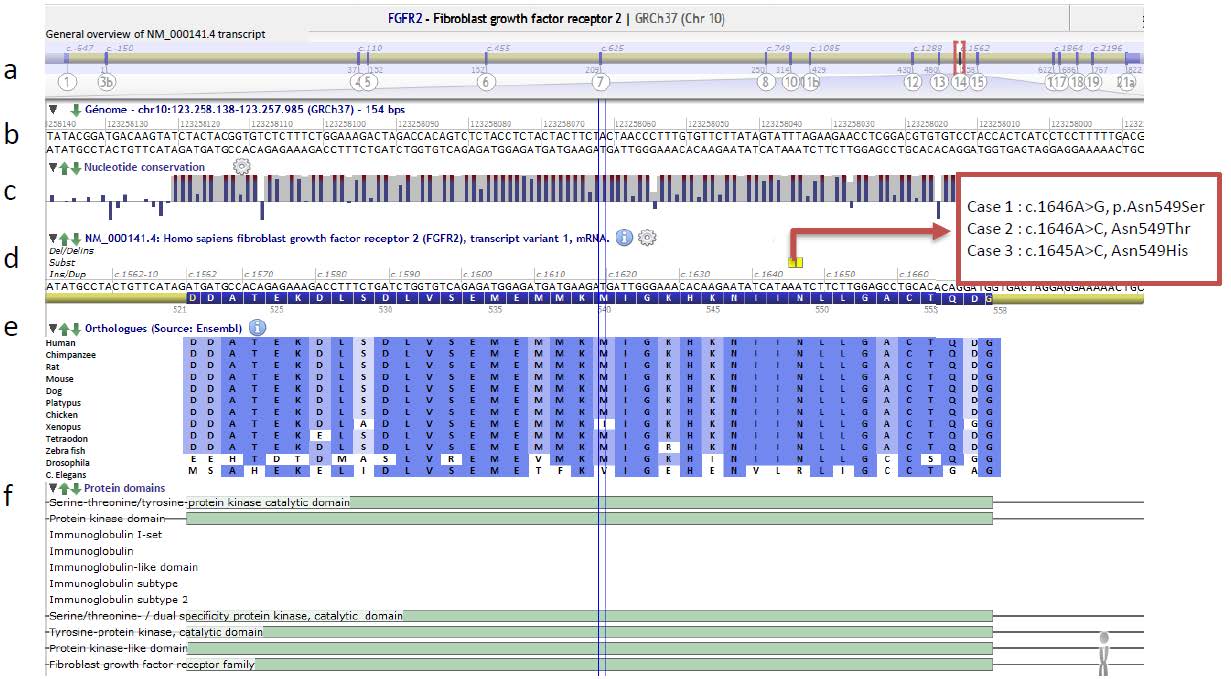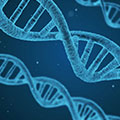1. Introduction
Craniosynostosis is a cranial malformation occurring in approximately 1 in 2500 live births. In around 15% of these cases [1,2], it is part of a craniofacial syndrome associating typical facial features such as exorbitism and maxillary retrusion to the premature fusion of cranial sutures [3]. Common variable features also include secondary complications, such as hydrocephalus, intellectual disability, or sleep apnea. However, the diversity of phenotypes is not always straightforwardly explained by the genetic alteration. Knowing the phenotypical prognosis helps managing and preventing some complications, by proposing early adapted treatment.
FGFR2 (Fibroblast Growth Factor Receptor 2) is akey gene involved in craniosynostosis syndromes such as Crouzon and Pfeiffer syndromes. It codes for a membrane receptor with three extracellular immunoglobulin(Ig)-like domains, a transmembrane domain and an intracellular tyrosine kinase (TK) domain. It is expressed from gastrulation onwards in the developing skeleton, particularly in the frontal bones of the skull and in the limbs [4].
Since 1994, many FGFR2 mutations have been identified in patients with Crouzon syndromes [4,5,6,7,8]. Most of them are missense mutations affecting the extracellular domain [9,10]. Besides, rare mutations affect the intracellular TK domain of FGFR2 with subsequent constitutive activation [9,11]. The clinical phenotypes associated with these rare mutations have been described but there is little genotype-phenotype correlation regarding subtle findings. Therefore, all cases must still be centralized and described precisely.
From a cohort of patients affected by craniofacial syndromes, we identified three patients with missense mutations affecting the same amino acid Asn549, located in the FGFR2 TK domain, we discuss their molecular mechanism and compare their phenotypes.
2. Materials and Methods
Blood samples were drawn for diagnostic purposes after informed consent. DNA was extracted using a QIAamp blood kit (Qiagen, Courtaboeuf, France). FGFR2 exons 4, 6, 8 (IIIa), 10 (IIIc), 11, 14, 15, 16, 17 were amplified and sequenced directly on both strands (Life technologies, Courtaboeuf, France) then analyzed using Sescape (Life Technologies and Alamut software (Interactive Biosoftware, Rouen, France). The NCBI reference sequences were FGFR2 (NM_000141.4) for c.DNA and FGFR2 (NG_012449.1) for exons numbering. The mutations nomenclature is based on HGVS nomenclature guidelines (http://www.hgvs.org/mutnomen).
Case reports
Patient 1 is a sixteen-year-old boy with Crouzon syndrome, showing facial retrusion and prominent forehead. His parents and four siblings show no clinical sign of craniosynostosis. Pregnancy was uneventful, head circumference at birth was 33 cm. He was born with isolated sagittal suture fusion. Hydrocephalus at birth required ventriculo-peritoneal shunt, that was removed at the age of ten, after decompression surgery. Other surgical history includes forehead advancement at one, and extensive frontal surgery at three, followed by frontal subcutaneous fat injection. He never presented papilledema. Recent brain imaging reveals asymptomatic cavum septum pellucidum, but no ventricular enlargement nor Chiari malformation, which is a displacement of cerebellar tonsils through the foramen magnum, sometimes associated with craniostenosis (Figure 1a). Recent clinical evaluation reveals frequent headaches, behavioral difficulties and intellectual disability (IQ 70), with normal neurological and sensory examination.
This patient presented c.1646A > G, p.Asn549Ser mutation, which has been reported in the Human Gene Mutation Database (Cardiff University, 2015) but has never been described clinically (Figure 2).
Patient 2 is a fifteen-year-old girl presenting with exorbitism, maxillary retrusion, and broad thumbs that corresponds to Pfeiffer syndrome. Parents have a normal appearance and further family history is unknown. Pregnancy was uneventful. She was born with coronal fusion, then developed premature sagittal fusion. Ventriculoperitoneal shunt was placed at the age of six weeks for hydrocephalus, and was removed at ten. She underwent bilateral parietal decompression at the age of four and ten, posterior decompression with distractors at thirteen. Ophthalmological examination revealed strabismus, which was treated surgically, and right ptosis. Neurological imaging shows Chiari malformation, which was operated at the age of five, complicated with cervical C3-C7 syrinx, and no intracranial malformation. Clinical examination shows unilateral hypoacousia, upper limbs paresthesias and lower limbs weakness that progressively got better after occipital foramen surgery. She presents behavioral abnormalities treated with ritaline but no major intellectual disability. She has sleep apnea syndrome, which required CPAP therapy at night for years and resolved after tonsillectomy.
She was diagnosed with c.1646A > C, Asn549Thr mutation, reported once [12] (Figure 2).
Patient 3 is a four-year-old boy presenting with typical Crouzon syndrome with exorbitism and maxillary retrusion, associated with right coronal suture fusion and lambdoid ridge at birth (Figure 1c, d, e). His father and father’s mother had a crouzonoid appearance but were not followed. Pregnancy was uneventful, head circumference at birth was 38.5 cm. He underwent fronto-orbital advancement with decompressive craniectomy at the age of one, tonsillectomy at two. At the age of three, he presented premature bilateral coronal and sagittal fusion, for which he underwent parietal decompression. Ophthalmological examination at the time revealed bilateral papilledema, a sign of hydrocephalus, that resolved after surgery, and left ptosis. Recent head CT scan shows asymptomatic cavum septum pellucidum, no ventricular enlargement nor cerebellar tonsils malformation (Figure 1b). There is no neurological or sensory impairment, and no major intellectual disability. He developed moderate sleep apnea syndrome (apnea+hypopnea index 0.8/min).
He presented with c.1645A > C, Asn549His mutation, which has been described already [9] (Figure 2).
3. Discussion
Mutations affecting FGFR2 TK domain are a subgroup of FGFR2 mutations found in syndromic craniosynostoses. They may correlate with a phenotypical subgroup, with particular characteristics and complications.
Although most FGFR2 mutations found in patients with Crouzon and Pfeiffer syndromes are located in exons 8 (IIIa) and 10 (IIIc) that encode the extracellular part of the protein [9,10], screening of patients with syndromic craniosynostosis has led to the identification of nine distinct mutations in FGFR2 intracellular TK domain (exons 14, 15, 16), accounting for~10% of patients with craniosynostosis [9,11,12,13,14]. In Necker-Enfants Malades Hospital, screening of FGFR2 in all patients with Crouzon and Pfeiffer syndromes led to the identification of 7.4% of TK domain mutations (5/67), 4 affecting Asn549 and one Lys659. Patients with other syndromic craniosynostoses did not present with TK domain mutations. Only three patients with Asn549 variants were available for complete clinical follow-up. The three mutations are localized in c.1645A and c.1646A, highly conserved nucleotides, which is consistent with their pathological impact (Figure 2). When screening FGFR2 for all patients with any syndromic craniosynostosis, Kan et al. found 6 mutations (7%, 6/85) occurring in the TK domain, in 8 patients (3%, 8/259) [9] which is consistent with our population. On the opposite, Roscioli et al. do not report any mutation in the TK domain in a review of 630 patients, but it is likely that they have not been screened for this domain [15].
The protein structure itself is not affected by the Asn549 changes, according to simulated Polyphen scores (score max=1 for both SIFT and Polyphen softwares). The mechanism by which these mutations lead to FGFR2 gain of function has been explored by Chen et al., who compared the crystal structures of wild-type FGFR2 kinase domain with those of N549H and N549T [11]. They found that these mutations lead to ligand-independent FGFR2 kinase activation by directly disengaging a molecular brake that is conserved in a wide range of receptors tyrosine kinase. More precisely, N549 maps onto the kinase hinge (the linker between β5 strand and αD helix). Crystal analysis of the hinge region of the N549H and N549T mutant kinases reveals the loss of the hydrogen bonds between mutated residue 549 and the backbone atoms of the loop between the αC helix and the β4 strand, relaxing the N-lobe to rotate towards the C-lobe. This mechanism prevents normal function of this molecular break and constitutively activates FGFR2 for p.Asn549His and p.Asn549Thr changes. We can hypothesize that the Asn549Ser mutation has the same effect.
On a phenotypical point of view, the three patients we report present with typical Crouzon or Pfeiffer syndrome: exorbitism, maxillary retrusion, premature suture fusion, and one patient with hand abnormalities. However, the three of them developed hydrocephalus, which happens in only 40% of patients with Crouzon and Pfeiffer syndrome in general [16]. Two patients have a cavum septum pellucidum, which is found in only 1.1% of general population. Among patients with syndromic craniosynostosis, cavum septum pellucidum has been reported in 25% of patients with Apert syndrome, a congenital disorder characterized by craniosynostosis associated with malformations of the hands and feet [17], but not in Crouzon patients. This finding was considered incidental, but may also be interpreted as obstructing cerebrospinal fluid circulation, and thus causing hydrocephalus. Hydrocephalus may cause intellectual disability, which could explain this tendency in our three patients, and in the cases reported by Wilkie et al. and Kan et al. [9,12].
The two patients with p.Asn549His mutations reported by Kan et al. display Crouzon appearance with developmental delay and hydrocephalus, and one of them has craniosynostosis with Chiari malformation, while the other has macrocephaly [9]. The newly reported p.Asn549Ser mutation is also associated, in our case, with hydrocephalus and secondary intellectual disability.
Overall, although no definitive conclusion can be drawn from so few cases, hydrocephalus seems to be an atypically frequent feature in patients with mutations in the FGFR2 TK domain: patients with p.Lys526Glu mutation display scaphocephaly with intellectual disability [18]. Kan et al. already reported that hydrocephalus and intellectual disability were over-represented in patients with TK domains mutations compared with typical Crouzon and Pfeiffer syndromes [9].
4. Conclusion
Patients with Crouzon and Pfeiffer syndromes presenting with missense mutations of Asn549 residue, located in FGFR2 TK domain, are at high risk of developing hydrocephalus. Therefore, regular imaging and clinical monitoring is useful to treat hydrocephalus as early as possible and prevent secondary intellectual disability.
Conflict of interest
All authors declare no conflict of interest in this paper.










 DownLoad:
DownLoad: 





